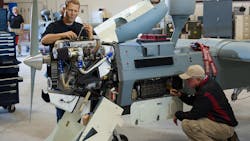In use since 1996, the RQ-5A Hunter was the U.S. Army’s first fielded unmanned aircraft system (UAS). In many ways, it set the bar by providing warfighters with reconnaissance, surveillance, target acquisition (RSTA), communications relay, and weapons delivery operations. In fact, the next-generation MQ-5B Hunter UAS recently surpassed 100,000 combat flight hours in service. With a multimission optronic payload, the MQ-5B gathers RSTA information in real time, relaying it via video link to soldiers and commanders on the ground.
The MQ-5B Hunter system, contracted by Northrop Grumman, uses the Army’s One System ground-control station and remote video terminal. It relies on a communications relay package to extend its radio range. Communications are sent over C-Band or tactical-common-data-link (TCDL) line-of-sight (LOS) data links. This aspect allows for the broadcasting of sensor data that enhances situational awareness. In doing so, it enables more proactive planning and the execution of decisive operations. A relay mode allows for the system to be controlled by other unmanned aerial vehicles (UAVs) at extended ranges or over difficult terrains.
The UAS is equipped with a differential GPS automatic takeoff and landing system. It is easily distinguished by its heavy fuel engines—one serves to “push” the system while the other “pulls.” The engines allow the Hunter to climb quickly, operate at high altitudes, and display endurance (up to 21 hrs.) while reducing maintenance time and operation support costs. It also houses a “wet,” or fuel-carrying, extended center wing with weapons-capable hard points and a modern avionics suite.
About the Author
Iliza Sokol
Associate Digital Editor
Iliza joined the Penton Media group in 2013 after graduating from the Fashion Institute of Technology with a BS in Advertising and Marketing Communications. Prior to joining the staff, she worked at NYLON Magazine and a ghostwriting firm based in New York.
